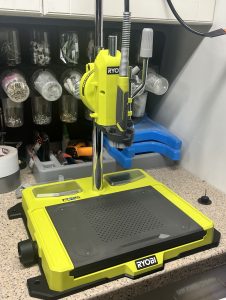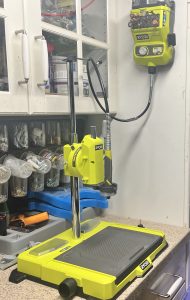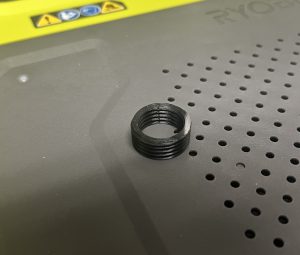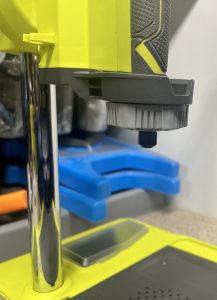-
Fixing Battery Drain in Kwikset Locks
Almost 10 years ago I installed Kwikset Z-Wave locks on our doors. They had been working well for years, but I noticed that the batteries drained faster than I had expected. I attributed this to buying refurbished or b stock locks and just tried to get batteries that lasted longer. Last December I decided to replace the locks with new ones that hopefully drained the batteries slower.
The locks appeared to drain slower initially, but I wasn't get the year out of a set of batteries that I had read others could get; I could get a few months. After one of the updates to Home Assistant, I noticed in the Logbook that it recorded Z-Wave commands. In the list of commands were a bunch of "lock" commands sent to one of the locks; about once every 30 seconds at night.
Ah ha! It finally dawned on me. In my Node-RED automations, I had it setup to lock the garage door lock at night if the door was closed. This was repeated every 30 seconds. I had thought that if the lock was locked, nothing would happen. That was not the case as Home Assistant happily sent the command causing the lock to wake up every 30 seconds. The fix was quite simple: before sending the lock command check the state of the lock as Home Assistant stored this without having to poll the lock. With this simple change I stopped seeing the Z-Wave lock command and knock on wood, the batteries are lasting longer!
-
Review: Ryobi Hobby Station (and a missed opportunity)
I love having the right tools for the job whether it is software tools or physical tools to tackle projects around the house. As I've mentioned before, I really like the Ryobi 18V One+ line of tools. I have a number of the tools and keep adding to my collection. While the tools may not be contractor grade, they are more than enough for my uses.
Last year they announced a number of new tools in their collection including a new Power Source that can charge batteries from USB-C as well as power USB-C devices. Unfortunately the product isn't available and I check Ryobi's website every few days to see if the "Coming Soon" button changes to "Buy Now".
A few weeks ago when I was checking the site, I noticed the Hobby Station which takes on of Ryobi's rotary tools and turns it into a drill press and holds the tool making it easier to use. This was a little expensive for what it was, but I decided to order it. Even though I don't own any of the rotary tools that Ryobi says works with it, I though that I might be able to use my P460 Rotary Tool Station with it if I screwed off the top housing. What I didn't realize at the time is that the diameter of that housing and the diameter of the tools that are designed to work with the station are different.
The Hobby Station arrived and I quickly set it up. When I put the tool in the holder, I found my mistake where the tool was too small. However, that didn't deter me. I screwed the tool in place and it gripped the rubber and seemed fairly secure. Perfect, I didn't have to return it!


Later I thought about the main nut holding the tool in place digging into the rubber and didn't like it. So I looked for a reducer bushing and thought I found an irrigation one at Home Depot, but realized that the threads probably wouldn't match. Not deterred by this, I asked my son if he could design a part and I could 3D print it. After a number of test prints, we had a working bushing! While it isn't an exact fit, the plastic is soft enough that the threads of the tools can dig into it and provide a fairly tight fit.

Now that I had a working hobby station, what do I think? For starters, the drill press has limited utility. With my solution, there is a bit of wiggle in the tool and frankly, how often have I needed a drill press? The station does hold the tool and make it easier for me to just hold the working piece. The angle adjustment is somewhat useful as I can see myself using it facing straight down or at a 90 degree angle. I don't know how much I'll use the fence that comes with it or use the vacuum attachment.

Pros
- Convenient way to hold a rotary tool
- Flexible angles to hold tool
- Appears well made
Cons
- Only works with some rotary tools
- Drill press has limited utility
- Over priced
Summary
This tool is definitely over priced and has limited utility for many people. It isn't a precision instrument which is needed for a drill press. It does seem like it is built solidly and will work for my needs; holding the rotary tool while I work on something is very useful for me.Unfortunately I can't recommend this to others; I will keep mine, but there are probably better solutions out there. If Ryobi had included a reducer bushing to fit their other rotary tools, it may have been a more compelling purchase and would definitely increase potential buyers.
-
Review: Costco Optical
I've been wearing glasses or contacts since I was about 12. As I've aged, my eyes have gotten worse and my glasses prescription has become more complex. For the last 20 years or so, I've bought my glasses from the optician associated with my optometrist or ophthalmologist. Vision insurance paid for some of the cost, but had to be used at certain locations. Even with insurance, my glasses cost a lot so I had to wait every 2 years before getting a new pair; I believe my last pair of glasses cost over $600 out of pocket with insurance picking up about the same. That's just crazy for a pair of glasses!
My parents have been using Costco Optical for years and have generally been satisfied with them. This year after my eye exam, I wasn't eligible for insurance to cover anything on my glasses, so I decided to try out Costco. My ophthalmologist warned me about their lenses and said they weren't as good as the ones her optician sold. How many companies actually manufacture lenses? I know that Luxottica basically has corned the market on vision insurance, frames, lenses and retail outlets! I figured I didn't have much to risk trying out Costco; they do have their own lab in Chula Vista (south of San Diego) and computers do most of the work grinding the lenses.
A few weeks ago, we went to Eyeglass World to buy my son new glasses (he wanted the same ones he already had so that was easy). My wife and I looked at frames and they had a decent selection of frames. Going through the numbers, 2 pair of glasses for me (regular glasses and computer glasses) would have been $700, I believe. We decided to visit Costco to see what they could do. Costco's frame selection isn't as large, but we both managed to find frames that we liked. I found "designer" Oakley frames that were about $85 (frame only) vs the standard frames that ran about $50; definitely lower priced than other places, but the frame price is only a small fraction of the cost of a pair of glasses for me.
My wife picked out sunglasses and regular glasses; I picked regular and computer glasses. Both of us have pretty bad eyes and need progressive lenses in high index material that tends to drive up the price. I like transitions (darkening) in my regular glasses so that adds to the cost. By the time we were done with our glasses, it cost us $700 for 4 pair of glasses (my wife had about $150 in insurance benefit)! Wow, after we paid I told my wife that if the glasses work out, there will never be a reason for me to wait for insurance to kick in to buy new ones!
I've been wearing the glasses for a few weeks now and it took a little getting used to the computer glasses (the other glasses are about the same prescription as my last ones). I'm pretty impressed with them; I can see well and I really like the frames. The optician I went to had 1 or 2 men's styles and nothing like what I got. I'm really kind of surprised how much I like my glasses. They seem well made and the prescription seems on target.
Pros
- Excellent price
- Backed by Costco
- 90 day guarantee to make it right (i.e. wrong prescription, made wrong, etc.)
Cons
- Limited selection of frames
- Limited choices on lens options (Costco offered 2 types of Transitions; Eyeglass World offered 4 including 1 that would change while driving)
Summary
If you wear glasses and need new ones, I would definitely check out Costco. The price is truly amazing and I couldn't be happier with the quality of the lenses. -
Does privacy really exist?
The other day my wife and I were talking about the Live scan requirement for AB 506 that I'll have to do as I'm a Scout leader even though I have been live scanned before to renew my EMT certification once. Live scan is done on a per organization/company basis and is a snapshot in time making it somewhat pointless in my opinion.
My wife suggested that the live scan results aren't shared because of privacy concerns which got me thinking about how much privacy most people can have in today's society.
Whether you like it or not, you're being tracked by the government and various companies. For instance, every time you use a credit card, the date/time, location, and name of the vendor is tracked by the credit card company. While it may be to help prevent fraud, they can build a pretty detailed picture of you just based on your buying habits. Likewise if you have a club card at a super market or shop at Costco, you can bet the data is being used to target you for ads.
Many people don't realize that they've accepted this "invasion" of privacy as they have to sacrifice it for convenience. In addition to your shopping habits, if you own your house it does not take much to figure out where you live.
Let's get into the more subtle ways you're being tracked. I just read an article the other day how many law enforcement agencies in San Diego county are using License Plate Readers (LPR) which can give law enforcement a decent idea of your driving habits if you happen to pass by the readers (some are on police cars and others may be stationary). LPR is not just used by law enforcement. The University Town Center mall uses LPR in its parking garages so you can exit without having to insert your ticket in the machine. If you frequent the mall, your habits are being tracked.
If you think that your ad blocker and turning off location services on your cell phone prevent you from being tracked, you're mistaken. Cell phone companies can know which cell towers your phone hits as it is required in order to route calls to you. Do they keep that data and do something with it? I have no idea, but it is quite possible and not just some made up stuff seen in TV shows.
Do you have a car with "connected services" in it? You're being tracked. While you can ask the company to turn off all services, you lose the ability to have collision notification, vehicle theft recovery and some other features. In order to have the convenience and safety of these features, your location is being tracked. I have no idea what the car manufacturers are doing with this data, but they're collecting it. Even if you don't subscribe to the services and don't explicitly opt-out, they still may collect the data as the cost to keep a live cellular connection in your car is minor compared to what they can do with your data.
Don't forget about your Netflix or Amazon Prime history. When and where you watch a show along with what the show is can be valuable data that forms a picture of who you are and what you do.
Is there anything you can do about staying private? I suppose you could always pay cash, stop using a cell phone, drive a car without connected services (or rip out the cellular connection), avoid all places with LPR, etc. Is this practical, not really? Does this mean you should just give up on privacy? I don't think so, but you have to be realistic on what you can control and how much will it inconvenience you.
Personally I'm not going to change my habits, but I am very cognizant of what I post, when I post it (posting stuff on vacation could give a clue that I'm away from home), and how much I share. That's really all I can do without wearing a tin foil hat and living off the grid.